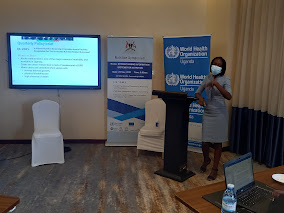Guidelines for Oral and Poster Presenations
National Nutrition Symposium 2022-Guidelines for Poster
And Oral Presentations
Specifications for Poster Presentations
- The recommended poster size is 1 meter by 2 meters (36 inches by 78 inches).
- The poster board number assigned to the poster must be placed in the upper left-hand corner of the display. A poster board number cut-out will be provided and must be visible at all times.
- Include, the abstract title, author and co-author names, and the institution(s) where the authors are affiliated.
- Place the e-mail address, phone, and fax numbers of the corresponding author in the upper right-hand corner of the poster board for attendees who desire further information.
- The post abstract should include “Abstract, Introduction/Background,” Methods/Materials,” “Results,” Discussion, Conclusions, References, and Acknowledgements” in district paragraphs with illustrative clear figure(s) where possible
- Refer to your acceptance letter and/or the final symposium program for the time and location of your poster session and set-up time.
- The designated poster presenter (author or co-author) must be present at the assigned space during the designated time to discuss the work presented.
Tips for Poster Preparation
- Posters should stimulate discussion, do not give a long presentation. Therefore, keep text to a minimum, emphasize graphics, and make sure every item included in your poster is relevant.
- Utilize handouts to supplement your poster to avoid text crowding
- Goal should be: 20% text, 40% graphics, 40% space with a word count of about 300 to 800
- Make sure ideas flow logically from one section to the next, and can be explained in 10 minutes.
- Use charts and graphs to illustrate data (avoid large tables of raw data).
- Use high resolution photographs (web images often will not work).
- Do not use all capital letters.
- The use of typewritten, handwritten or a printed PowerPoint presentation as a poster is unacceptable. Presentations in these formats will be removed.
- Be consistent:
o Keep consistent margins.
o Keep line spacing consistent.
o Keep the color, style, and thickness of borders the same.
o Keep shading consistent.
- Test readability
o Title of the poster should be readable from 20 feet (about 06 meters) away.
o Body text should be readable from 6 feet (about 02 meters) away.
o Bullets, numbering, and headlines should be used to make it easy to read
Specifications for Oral Presentation General Instructions
- Each presenter will be given a time slot of 15 minutes in total, which
is distributed as:
o 10 minutes of presentation
o 5 minutes of answering questions from the auditorium and changing of presenters at the podium
- Submit your presentation to the committee at least a day before your presentation to be uploaded. This will save time and any delay caused by any technical mishap.
NOTE: As the schedule of presentation sessions is tight it is of utmost importance that all presenters are ready and in time for their presentations. The introduction of each presenter will be kept brief when introduced by the moderator.
Technical Requirements PowerPoint Presentations
To design and deliver an effective presentation, it is not enough to stand up and reel off a series of facts and figures. You probably already have a good understanding of your subject and a general idea of what you want to say about it, but will this be sufficient to transmit the same understanding to your audience?
| Oral Presentation from 2021 symposium | Poster Presentation form 2021 symposium |
The Four Pre-Presentation P’s
Preparation The first step in preparing a presentation is thinking about the needs of your audience. Do you know who you will be talking to and what they care about? This will actually affect how your audience listens and should influence what information you include and how you deliver it. When preparing for your presentation, ask yourself who you will be speaking to. What are they interested in? How do you know? How is your topic relevant to the audience’s concerns? What kind of attitudes, positive or negative, are audience members likely to have toward your presentation? What are your main talking points, the information you really want them to remember? What do you want the audience to do after hearing your presentation? | Planning Planning your presentation is important. You must know what the important points and conclusions of your presentation are and build your talk around that structure. Listeners can easily lose the flow of a presentation jam-packed with raw data. The best structure tends to include an introduction, an elaborative body, and a conclusion, following the old adage, “Tell them what you’re going to tell them; then tell them; then tell them what you told them.” This approach is necessary because most people typically retain less than 50% of what they hear. Repetition and visual reinforcement help a great deal with retention. |
PowerPoint Number the slides and make sure that they are set up to show in the same order you plan to present the information. Remember that the slideshow is there to support you, not the other way around |
Practice
Practice at home, alone,
in front of a mirror, in front of a
video camera, in front of your
family. Watch and listen to recordings
of yourself. Watch your facial expressions
and the way your mouth moves. Get
feedback from others. Run through
it until you can do your presentation in your
sleep. Then you just might be ready to do it in public |
The Four P’s of Public Speaking
|
Projection Most people do not speak with sufficient volume when presenting. Breathing from your diaphragm will help you achieve this without becoming breathless. Additional volume can be used for emphasis and emotional impact |
Pitch
Raising or lowering your tone of voice can change the emotional mood of the presentation. |
|
Pacing Slowing down the speed of your speaking can emphasize key points or help build drama.
Occasionally speeding up can help relieve monotony and create excitement
Pace can also make key words or phrases seem bigger or smaller, less or more important. |
Pauses Pause before and on important points, both for emphasis and to give the audience time to understand and absorb them.
By varying your vocal volume, inflection, and pacing, and by skilfully using pauses, you can avoid a dull, monotone delivery. Remember that you must convey emotion to keep your audience’s attention. If your presentation lacks passion, conviction, enthusiasm or energy, your audience will become bored and tune you out. They can’t be expected to take interest in anything you don’t seem to have interest in yourself! |



Comments
Post a Comment